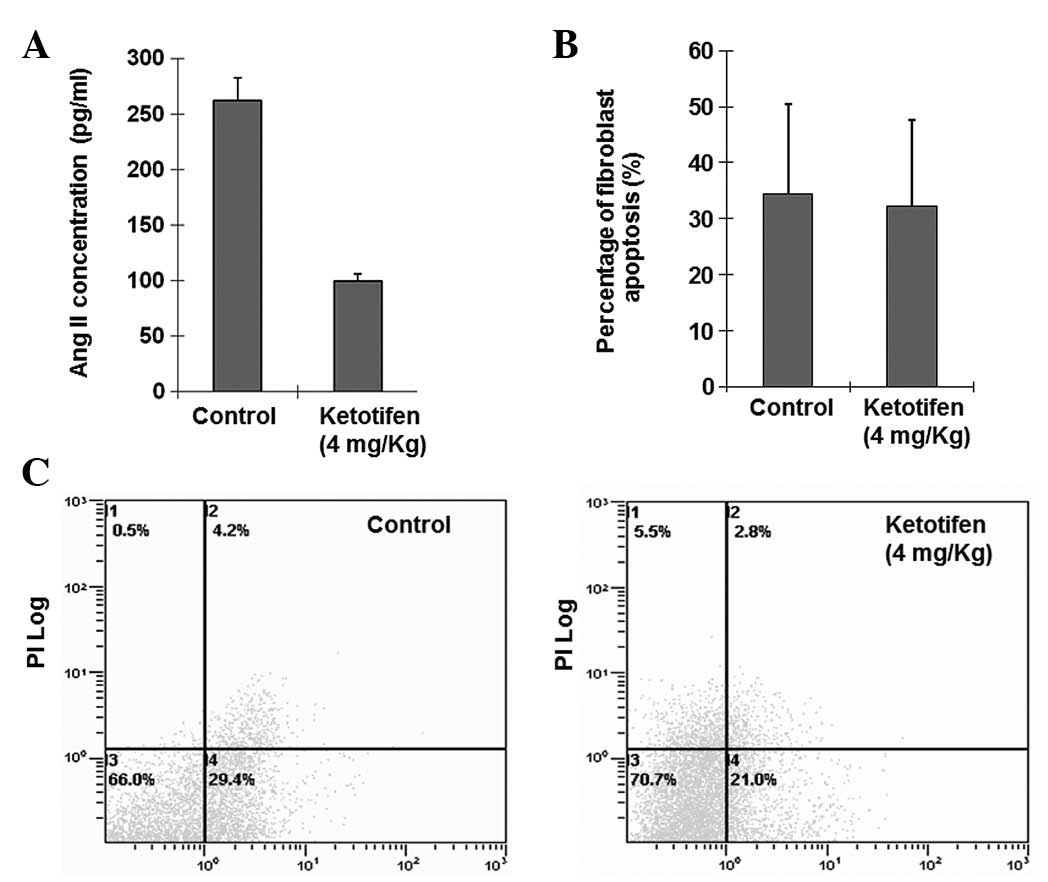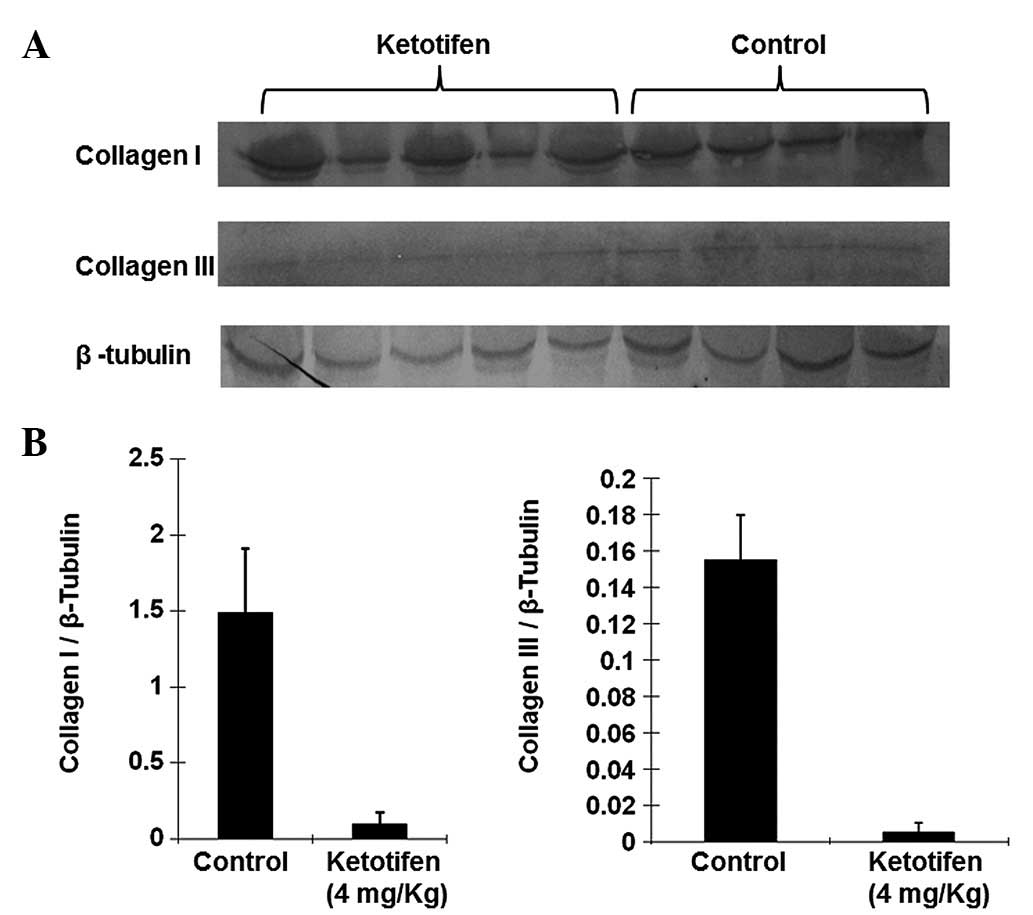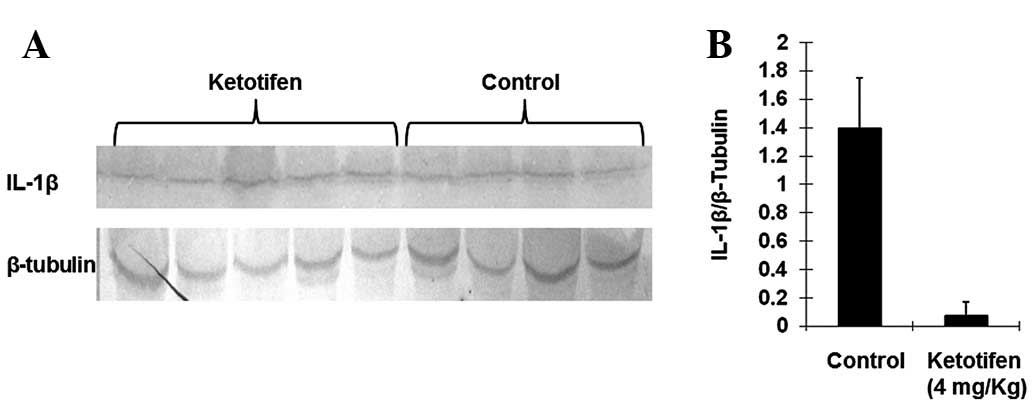|
1.
|
Räntfors J and Cassuto J: Role of
histamine receptors in the regulation of edema and circulation
postburn. Burns. 29:769–777. 2003.PubMed/NCBI
|
|
2.
|
Chen K, Chen J, Li D, Zhang X and Mehta
JL: Angiotensin II regulation of collagen type I expression in
cardiac fibroblasts: modulation by PPAR-gamma ligand pioglitazone.
Hypertension. 44:655–661. 2004. View Article : Google Scholar : PubMed/NCBI
|
|
3.
|
Persinger MA, Lepage P, Simard JP and
Parker GH: Mast cell numbers in incisional wounds in rat skin as a
function of distance, time and treatment. Br J Dermatol.
108:179–187. 1983. View Article : Google Scholar : PubMed/NCBI
|
|
4.
|
Lang YD, Chang SF, Wang LF and Chen CM:
Chymase mediates paraquat-induced collagen production in human lung
fibroblasts. Toxicol Lett. 193:19–25. 2010. View Article : Google Scholar : PubMed/NCBI
|
|
5.
|
Tomimori Y, Muto T, Saito K, et al:
Involvement of mast cell chymase in bleomycin-induced pulmonary
fibrosis in mice. Eur J Pharmacol. 478:179–185. 2003. View Article : Google Scholar : PubMed/NCBI
|
|
6.
|
Akgul A: Can cardiac fibrosis be
prevented? Mast cell inhibition versus anti-chymase activity. Eur J
Cardiothorac Surg. 35:553–554. 2009. View Article : Google Scholar : PubMed/NCBI
|
|
7.
|
Saarinen J, Kalkkinen N, Welgus HG and
Kovanen PT: Activation of human interstitial procollagenase through
direct cleavage of the Leu83-Thr84 bond by mast cell chymase. J
Biol Chem. 269:18134–18140. 1994.
|
|
8.
|
Vartio T, Seppä H and Vaheri A:
Susceptibility of soluble and matrix fibronectins to degradation by
tissue proteinases, mast cell chymase and cathepsin G. J Biol Chem.
256:471–477. 1981.PubMed/NCBI
|
|
9.
|
Takai S, Jin D, Sakaguchi M, et al: A
novel chymase inhibitor,
4-[1-([bis-(4-methyl-phenyl)-methyl]-carbamoyl)3-
(2-ethoxy-benzyl)-4-oxo-azetidine-2-yloxy]-benzoic acid (BCEAB),
suppressed cardiac fibrosis in cardiomyopathic hamsters. J
Pharmacol Exp Ther. 305:17–23. 2003.
|
|
10.
|
Doggrell SA and Wanstall JC: Vascular
chymase: pathophysiological role and therapeutic potential of
inhibition. Cardiovasc Res. 61:653–662. 2004. View Article : Google Scholar : PubMed/NCBI
|
|
11.
|
Takai S and Miyazaki M: A novel
therapeutic strategy against vascular disorders with chymase
inhibitor. Curr Vasc Pharmacol. 1:217–224. 2003. View Article : Google Scholar : PubMed/NCBI
|
|
12.
|
Le Noble FA, Hekking JW, Van Straaten HW,
Slaaf DW and Struyker Boudier HA: Angiotensin II stimulates
angiogenesis in the chorio-allantoic membrane of the chick embryo.
Eur J Pharmacol. 195:305–306. 1991.PubMed/NCBI
|
|
13.
|
Suzuki Y, Ruiz-Ortega M, Lorenzo O,
Ruperez M, Esteban V and Egido J: Inflammation and angiotensin II.
Int J Biochem Cell Biol. 35:881–900. 2003. View Article : Google Scholar
|
|
14.
|
Urata H and Ganten D: Cardiac angiotensin
II formation: the angiotensin-I converting enzyme and human
chymase. Eur Heart J. 14(Suppl 1): 177–182. 1993.PubMed/NCBI
|
|
15.
|
Shiota N, Fukamizu A, Takai S, Okunishi H,
Murakami K and Miyazaki M: Activation of angiotensin II-forming
chymase in the cardiomyopathic hamster heart. J Hypertens.
15:431–440. 1997. View Article : Google Scholar : PubMed/NCBI
|
|
16.
|
Takai S, Shiota N, Yamamoto D, Okunishi H
and Miyazaki M: Purification and characterization of angiotensin
II-generating chymase from hamster cheek pouch. Life Sci.
58:591–597. 1996. View Article : Google Scholar : PubMed/NCBI
|
|
17.
|
Nishikori Y, Kakizoe E, Kobayashi Y,
Shimoura K, Okunishi H and Dekio S: Skin mast cell promotion of
matrix remodeling in burn wound healing in mice: relevance of
chymase. Arch Dermatol Res. 290:553–560. 1998. View Article : Google Scholar : PubMed/NCBI
|
|
18.
|
Wu Q, Kuo HC and Deng GG: Serine proteases
and cardiac function. Biochim Biophys Acta. 1751:82–94. 2005.
View Article : Google Scholar : PubMed/NCBI
|
|
19.
|
Urata H, Kinoshita A, Misono KS, Bumpus FM
and Husain A: Identification of a highly specific chymase as the
major angiotensin II-forming enzyme in the human heart. J Biol
Chem. 265:22348–22357. 1990.PubMed/NCBI
|
|
20.
|
Chester AH and Borland JA:
Chymase-dependent angiotensin II formation in human blood vessels.
J Hum Hypertens. 14:373–376. 2000. View Article : Google Scholar : PubMed/NCBI
|
|
21.
|
Okunishi H, Miyazaki M, Okamura T and Toda
N: Different distribution of two types of angiotensin II-generating
enzymes in the aortic wall. Biochem Biophys Res Commun.
149:1186–1192. 1987. View Article : Google Scholar : PubMed/NCBI
|
|
22.
|
Voors AA, Pinto YM, Buikema H, et al: Dual
pathway for angiotensin II formation in human internal mammary
arteries. Br J Pharmacol. 125:1028–1032. 1998. View Article : Google Scholar : PubMed/NCBI
|
|
23.
|
Sakaguchi M, Takai S, Jin D, et al: A
specific chymase inhibitor, NK3201, suppresses bleomycin-induced
pulmonary fibrosis in hamsters. Eur J Pharmacol. 493:173–176. 2004.
View Article : Google Scholar : PubMed/NCBI
|
|
24.
|
Okamoto K, Tajima H, Ohta T, et al:
Angiotensin II induces tumor progression and fibrosis in
intrahepatic cholangiocarcinoma through an interaction with hepatic
stellate cells. Int J Oncol. 37:1251–1259. 2010. View Article : Google Scholar : PubMed/NCBI
|
|
25.
|
Schulman IH, Zhou MS, Treuer AV,
Chadipiralla K, Hare JM and Raij L: Altered renal expression of
angiotensin II receptors, renin receptor, and ACE-2 precede the
development of renal fibrosis in aging rats. Am J Nephrol.
32:249–261. 2010. View Article : Google Scholar : PubMed/NCBI
|
|
26.
|
Schellings MW, Vanhoutte D, Van Almen GC,
et al: Syndecan-1 amplifies angiotensin II-induced cardiac
fibrosis. Hypertension. 55:249–256. 2010. View Article : Google Scholar : PubMed/NCBI
|
|
27.
|
Sun Y, Zhang J, Zhang JQ and Ramires FJ:
Local angiotensin II and transforming growth factor-beta1 in renal
fibrosis of rats. Hypertension. 35:1078–1084. 2000. View Article : Google Scholar : PubMed/NCBI
|
|
28.
|
Yoshiji H, Kuriyama S, Yoshii J, et al:
Angiotensin-II type 1 receptor interaction is a major regulator for
liver fibrosis development in rats. Hepatology. 34:745–750. 2001.
View Article : Google Scholar : PubMed/NCBI
|
|
29.
|
Pulichino AM, Wang IM, Caron A, et al:
Identification of transforming growth factor beta1-driven genetic
programs of acute lung fibrosis. Am J Respir Cell Mol Biol.
39:324–336. 2008. View Article : Google Scholar : PubMed/NCBI
|
|
30.
|
Lijnen PJ, Petrov VV and Fagard RH:
Induction of cardiac fibrosis by transforming growth
factor-beta(1). Mol Genet Metab. 71:418–435. 2000. View Article : Google Scholar : PubMed/NCBI
|
|
31.
|
Tharaux PL, Chatziantoniou C, Fakhouri F
and Dussaule JC: Angiotensin II activates collagen I gene through a
mechanism involving the MAP/ER kinase pathway. Hypertension.
36:330–336. 2000. View Article : Google Scholar : PubMed/NCBI
|
|
32.
|
Weber KT and Brilla CG: Pathological
hypertrophy and cardiac interstitium. Fibrosis and
renin-angiotensin-aldosterone system. Circulation. 83:1849–1865.
1991. View Article : Google Scholar : PubMed/NCBI
|
|
33.
|
Kawaguchi Y, Takagi K, Hara M, et al:
Angiotensin II in the lesional skin of systemic sclerosis patients
contributes to tissue fibrosis via angiotensin II type 1 receptors.
Arthritis Rheum. 50:216–226. 2004. View Article : Google Scholar : PubMed/NCBI
|
|
34.
|
Heikkilä HM, Lätti S, Leskinen MJ, Hakala
JK, Kovanen PT and Lindstedt KA: Activated mast cells induce
endothelial cell apoptosis by a combined action of chymase and
tumor necrosis factor-alpha. Arterioscler Thromb Vasc Biol.
28:309–314. 2008.PubMed/NCBI
|
|
35.
|
Leskinen MJ, Heikkilä HM, Speer MY, Hakala
JK, Laine M, Kovanen PT and Lindstedt KA: Mast cell chymase induces
smooth muscle cell apoptosis by disrupting NF-kappaB-mediated
survival signaling. Exp Cell Res. 312:1289–1298. 2006. View Article : Google Scholar : PubMed/NCBI
|
|
36.
|
Sun J, Zhang J, Lindholt JS, et al:
Critical role of mast cell chymase in mouse abdominal aortic
aneurysm formation. Circulation. 120:973–982. 2009. View Article : Google Scholar : PubMed/NCBI
|
|
37.
|
He S and Walls AF: Human mast cell chymase
induces the accumulation of neutrophils, eosinophils and other
inflammatory cells in vivo. Br J Pharmacol. 125:1491–1500. 1998.
View Article : Google Scholar : PubMed/NCBI
|
|
38.
|
Ishida K, Takai S, Murano M, et al: Role
of chymase-dependent matrix metalloproteinase-9 activation in mice
with dextran sodium sulfate-induced colitis. J Pharmacol Exp Ther.
324:422–426. 2008. View Article : Google Scholar : PubMed/NCBI
|
|
39.
|
Mizutani H, Schechter N, Lazarus G, Black
RA and Kupper TS: Rapid and specific conversion of precursor
interleukin 1 beta (IL-1 beta) to an active IL-1 species by human
mast cell chymase. J Exp Med. 174:821–825. 1991. View Article : Google Scholar : PubMed/NCBI
|
|
40.
|
Santos FX, Arroyo C, Garcia I, et al: Role
of mast cells in the pathogenesis of postburn inflammatory
response: reactive oxygen species as mast cell stimulators. Burns.
26:145–147. 2000. View Article : Google Scholar : PubMed/NCBI
|
|
41.
|
Dong X, Chen J, Zhang Y and Cen Y: Mast
cell chymase promotes cell proliferation and expression of certain
cytokines in a dose-dependent manner. Mol Med Rep. 5:1487–1490.
2012.PubMed/NCBI
|













